Intel Mobile Penryn Benchmarked: Battery Life Improves Again
by Anand Lal Shimpi on January 7, 2008 12:00 AM EST- Posted in
- CPUs
Increasing Battery Life: It’s the Centrino Way
Intel sent us two Dell Latitude D630 notebooks, identically configured, with one variable: the CPU. In one D630, we had a Core 2 Duo T7800, which is a Merom based chip running at 2.6GHz with an 800MHz FSB and a 4MB L2 cache. The other D630 came equipped with a new 45nm Core 2 Duo T9500, also running at 2.6GHz/800MHz but with a larger 6MB L2 cache.
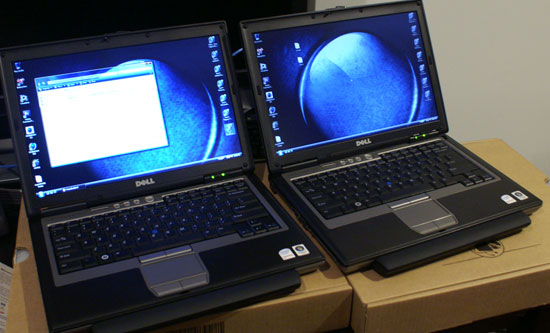
The CPU-Z shots will show that our T9500 CPU ran at 1.15V instead of the 1.225V of the T7800; a reduction in voltage translates directly into a reduction in power consumption of course, meaning longer battery life in a notebook. The question we had was: how much?
Merom:
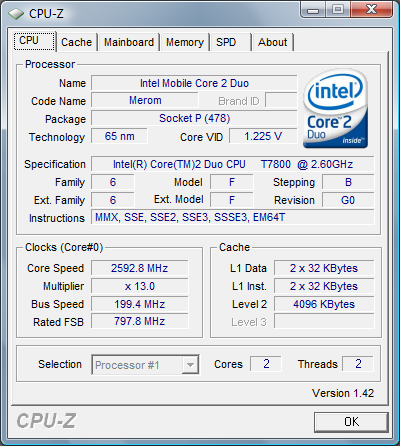
Penryn:

While the CPU is one of the single most power hungry components in a notebook, there are other power hogs as well. The display being one of the most obvious, but other components like the memory, hard drive, chipset and integrated graphics all contribute to the generally mediocre battery life you find in modern day notebooks. All of these power hungry components eat away at that stored energy, so how much could an evolutionary reduction in power actually bring?
To find out if we turned to MobileMark 2007, the latest battery life measurement tool from BAPCo. The MobileMark 2007 suite consists of three individual benchmarks: the Productivity 2007 test, the Reader 2007 test and the DVD playback test.
The Productivity 2007 test mimics what happens in the SYSMark 2007 Productivity test, the only difference being that MobileMark focuses on how long the battery will last, not how fast the system can perform.
We configured both systems identically, LCD brightness was set at three levels down from the maximum and Vista power management settings were set to balanced. To no one’s surprise, the Core 2 Duo T9500 managed to outlast the T7800; it was the margin of victory however that was most surprising.
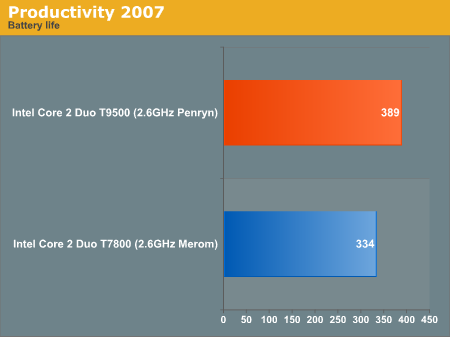
The T9500 lasted an extra 55 minutes, or an increase of almost 16.5% in battery life. We were concerned that the Productivity test over emphasized the impact of Penryn on battery life, so we turned to the other tests in MobileMark.
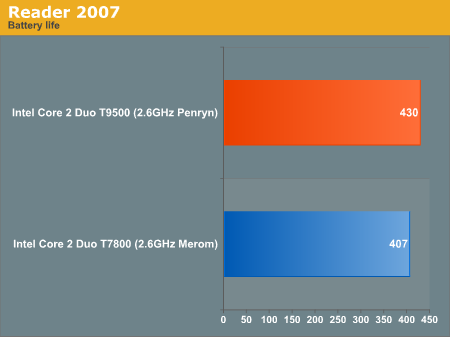
The Reader 2007 test is mostly idle time, simulating a user reading through documents on a notebook. Despite the very light load, battery life went up 5.6% or a total of 23 minutes on the Penryn system compared to the older Merom based T7800. While not nearly as dramatic as the Productivity 2007 test, the Reader benchmark shows significant improvement especially when you take into account that the only change here is the processor.
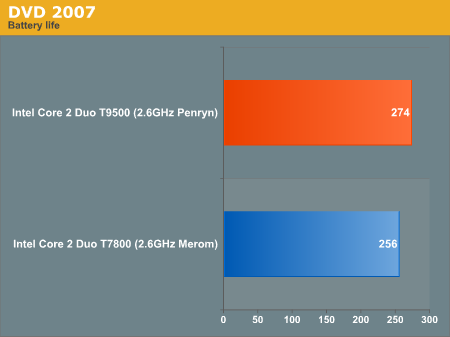
The DVD playback benchmark measures battery life while, you guessed it, playing back a DVD. While we don’t even want to begin to think of what battery life would be like playing back a HD-DVD or Blu-ray movie, regular DVDs are still quite manageable. The move to 45nm gave us an extra 18 minutes of battery life when playing back a DVD, an increase of 7%.
While the Productivity results may be a bit extreme, we believe it would be safe to say that the mobile version of Penryn can easily improve battery life on the order of 5 - 10% over an identically configured Merom/Santa Rosa system. Under very specific cases, especially if you’re looking at applications where Penryn is significantly faster than Merom (e.g. SSE4 optimized apps), battery life can improve even more dramatically
Herein lies the strength of these yearly Centrino updates; these increases in battery life will come at no additional cost to the end user. Dell will begin shipping its D630 notebooks with these Core 2 Duo T9500 processors starting in February, at no price premium compared to its current D630 lineup. The T9500 will simply replace the T7800 as the 2.6GHz processor option.










18 Comments
View All Comments
sprockkets - Monday, January 7, 2008 - link
Looking for cheap 45nm desktop CPUs.I was going to build Intel for my latest customer, but at current prices of the 2.1ghz X2 vs. 1.6ghz Pentiums, AMD won again for being at least $35 cheaper.
eye smite - Monday, January 7, 2008 - link
It's interesting to see what intel does, but I'll stick with my turion laptop from 2k5.deeman - Monday, January 7, 2008 - link
I think Intel has moved Cantiga forward a bit from Feb/March to 2nd quarter, but not too far for me to think now is the time to upgrade only the CPU and retain the current Santa Rosa chipset.I am happy with my current battery life, but think a huge improvement will come in another quarter when Cantiga / Penryn / and a few other improvements like LED backlit screens, become more available and rolled together. With the chipset change, I am hoping for a much more significant change when largely idle (such as editing) along with the other benefits Cantiga should bring.
My thoughts would be to hold off, but am interested in other opinions on what Cantiga will bring to overall battery life.
somedude1234 - Monday, January 7, 2008 - link
These new mobile penryn's seem like the ideal candidates for an ultra-low power HTPC that still has enough power to handle the tough encoding jobs.Does anyone know if any of the motherboard vendors are planning on releasing desktop boards for these new chips?
bugs1109 - Tuesday, January 8, 2008 - link
I think AOpen will release a motherboard that will use this penryn mobile processor. They currently have desktop motherboards that takes mobile cpu.Chris Peredun - Monday, January 7, 2008 - link
I hate to be "That Guy" but I'm pretty sure you mean "Battery Life" not "Battery Live."Unless it's a description of the PR walloping that Microsoft is taking over the Xbox Live outage. ;)
Wesley Fink - Monday, January 7, 2008 - link
Thanks for the catch. The Title is corrected, but it wil not update until the next refresh, so please be patient for a few minutes.Cygni - Monday, January 7, 2008 - link
Just a heads-up, charts on page 4 are borked. ;)